Thu, 01 Apr 2010 00:00 EDT
ScienceDaily
Some
13,000 years ago the Earth was struck by thousands of Tunguska-sized
cometary fragments over the course of an hour, leading to a dramatic
cooling of the planet, according to astronomer Professor Bill Napier of
the Cardiff University Astrobiology Centre.
He presents his new model in the journal Monthly Notices of the Royal Astronomical Society.
The cooling, by as much as 8°C, interrupted the warming which
was occurring at the end of the last ice age and caused glaciers to
re-advance. Evidence has been found that this catastrophic change was
associated with some extraordinary extraterrestrial event. The boundary
is marked by the occurrence of a "black mat" layer a few centimetres
thick found at many sites throughout the United States containing high
levels of soot indicative of continental-scale wildfires, as well as
microscopic hexagonal diamonds (nanodiamonds) which are produced by
shocks and are only found in meteorites or impact craters. These
findings led to the suggestion that the catastrophic changes of that
time were caused by the impact of an asteroid or comet 4 km across on
the Laurentide ice sheet, which at that time covered what would become
Canada and the northern part of the United States.
The cooling lasted over a thousand years, and its
onset coincides with the rapid extinction of 35 genera of North
American mammals, as well as the disruption of the Palaeoindian
culture. The chief objection to the idea of a big impact is that the
odds against the Earth being struck by an asteroid this large only
13,000 years ago are a thousand to one against. And the heat generated
by the rising fireball would be limited by the curvature of the horizon
and could not explain the continent-wide occurrence of wildfires.
Professor Napier has now come up with an astronomical model
which accounts for the major features of the catastrophe without
involving such an improbable event. According to his model, the Earth
ran into a dense trail of material from a large disintegrating comet.
He points out that there
is compelling evidence that such a comet entered the inner planetary
system between 20 000 and 30 000 years ago and has been fragmenting
ever since, giving rise to a number of closely related meteor streams
and co-moving asteroids known as the Taurid Complex.
In the course of the giant comet's disintegration, the environment of
the interplanetary system would have been hazardous and the Earth would
probably have run through at least one dense swarm of cometary
material. The new model indicates that such an encounter would last for
about an hour during which thousands of impacts would take place over
continental dimensions, each releasing the energy of a megaton-class
nuclear bomb, generating the extensive wildfires which took place at
that time. The nanodiamonds at the extinction boundary would then be
explained as having come in with the comet swarm.
One recent meteorite is known which may have come from this
giant comet progenitor: the Tagish Lake meteorite, which fell over
Yukon Territory in January 2000. It has the highest abundance of
nanodiamonds of any meteorite so far analysed.
Professor Napier sums up his model: "A large comet has been
disintegrating in the near-Earth environment for the past 20,000 to
30,000 years, and running into thousands of fragments from this comet
is a much more likely event than a single large collision. It gives a
convincing match to the major geophysical features at this boundary."
Journal Reference:
Napier W. M. "Paleolithic extinctions and the Taurid Complex." Monthly Notices of the Royal Astronomical Society, 2010; (in press) [link]
UK Daily Mail
Fri, 02 Apr 2010 18:09 EDT
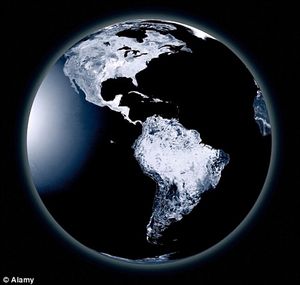
© Alamy
"New" theory: An hour-long hailstorm from space bombarded the Earth 13,000 years ago - plunging the planet into a mini-ice age
"New" theory: An hour-long hailstorm from space bombarded the Earth 13,000 years ago - plunging the planet into a mini-ice age
An
hour-long hailstorm from space bombarded the Earth 13,000 years ago -
plunging the planet into a mini-ice age, scientists claimed today.
The catastrophe was caused by a disintegrating comet and saw
the planet sprayed by thousands of frozen boulders made of ice and
dust.
The collisions wiped out huge numbers of animal species all
over the world, disrupted the lives of our stone age ancestors and
triggered a freeze that lasted more than 1,000 years.
The theory is the brainchild of Professor Bill Napier, from Cardiff
University, who says it explains the mysterious period of extinction
around 11,000 BC.
Scientists have long been puzzled by what caused a sudden
cooling of up to 8C (14F) just as the Earth was warming up at the end
of the last ice age.
The change in climate caused retreating glaciers to advance
once again, and coincided with the extinction of 35 families of North
American mammals.
Some geologists have argued that the world was hit by
a giant asteroid - a smaller version of one which wiped out the
dinosaurs 65 million years ago.
The collision left behind tell-tale traces in the rocks -
including a black 'mat' of soot an inch thick thought to have been
created by continental wide wildfires.
Microscopic 'nanodiamonds' created in massive shocks and only
found in meteorites or impact craters have also been discovered dating
back to the disaster.
These findings have led to claims that a 2.5 mile long comet or
asteroid smashed into the ice sheet covering what is now Canada and the
northern US.
But other scientists say the chances of the Earth being struck
by such a large object only 13,000 years ago are one thousand to one
against. And they say a single impact cannot explain such widespread
fires.
Professor Napier's theory suggests the devastation took place
when the Earth strayed into a dense trail of fragments shed by a large
comet.
Thousands
of chunks of material from the comet would have rained down on Earth,
each one releasing the energy of a one megaton nuclear bomb.
The impacts would have filled the atmosphere with smoke and soot and blotting out the Sun.
Prof Napier says a comet swooped into the inner solar system between
20,000 and 30,000 years ago and has been breaking apart ever since.
'A large comet has been disintegrating in the near-Earth
environment for the past 20,000 to 30,000 years and running into
thousands of fragments from this comet is a much more likely event than
a single collision,' said Professor Napier.
His model, published in the journal Monthly Notices of the Royal Astronomical Society, suggests that the 'hailstorm' would have only lasted about an hour.
It would have caused thousands of impacts, generating global
fires and depositing nanodiamonds at the 'extinction boundary' marking
the point in time when many species died out.
One recent impact that may have come from the comet is known as the Tagish Lake meteorite, said Professor Napier.
The object fell on Yukon Territory in Canada in January 2000.
It contained the largest amount of nanodiamonds of any meteorite
studied so far.
Comment: Finally, some mainstream verification of what Sott.net has been saying for years is coming through the information blackout. In February media outlets carried reports that a swarm of comet debris may have caused the 'Dark Ages' circa 500 AD. Bill Napier, as well as Victor Clube, deserve major recognition for their dedication in putting many of the puzzle pieces together. The Cycle of Cosmic Catastrophes by Firestone, West and Warwick-Smith is the seminal book on this cometary bombardment, the Younger Dryas Impact Event, at the end of the last Ice Age.
Besides older comets that break up and leave debris trails through which the Earth periodically passes, Laura Knight-Jadczyk's tireless research
has led us to consider the cyclical mechanism by which comets from the
Oort Cloud surrounding the outer solar system are knocked into the
inner solar system by the return of the Sun's dark star companion, 'Nemesis.'
We've been observing the steady increase in the number of fireball sightings, the cooling of the upper atmosphere, strange cloud formations and recent comet impacts on other planets in our solar system. Taken with research which reveals that our environment is constantly affected by interaction with comet dust (sometimes laden with larger fragments) and cosmic radiation,
we've deduced that our Big Blue Marble is once again on the threshold
of encountering a cosmic storm. In fact, it's overdue for the Perfect
Storm as several cycles return together.
Something Wicked This Way Comes, a Sott.net production:
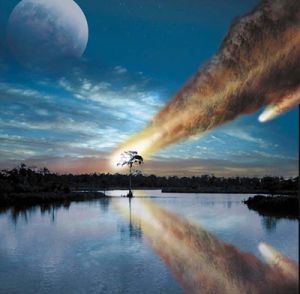
© U.S. Geological Survey
A sudden plunge of global temperatures 12,900 years ago may have been caused by a comet impact, a British researcher argues.
A sudden plunge of global temperatures 12,900 years ago may have been caused by a comet impact, a British researcher argues.
Paris-
A sudden plunge of global temperatures at the dawn of human
civilisation may have been caused by a comet impact, a British
researcher argues.
Known as 'the Younger Dryas', it has been also called the Big
Freeze and the Last Blast of the Ice Age - but for researchers trying
to understand the Earth's ancient climate, it's one of the big
mysteries of the field.
Around 12,900 years ago, Earth was on a steadily warming trend
after almost 100,000 years of harsh glaciation, during which ice sheets
placed a swathe of the northern hemisphere under a dead hand, extending
their thrall as far as south as New England and Wales.
Unexpected plunge in temperature
But just as the glaciers were beginning to retreat, and an easier life
at last beckoned for Earth's tiny population of humans, everything went
into reverse.
Temperatures fell dramatically by up to 8˚C, heralding a cruel winter that would last 1,300 years. But what caused it?
Crunching powerful equations and weighing fresh evidence, an
astrobiologist in Britain is pointing the finger at an unusual culprit.
Massive comet
Earth collided with debris from a vast comet, measuring 50 to
100 km across, that had wandered into the inner Solar System some
30,000 years ago before breaking up, says Bill Napier, a professor at
Cardiff University's Astrobiology Centre.
The impact unleashed a firestorm that blanketed the atmosphere
with ash and dust, reducing heat and light from the Sun, Napier
suggests in Monthly Notices, a journal of the Royal Astronomical Society.
What is worrying, adds Napier, is that our planet still crosses the
path of the remaining orbiting cometary rubble, a well-observed,
although still enigmatic, phenomenon called the Taurid Complex. Many of
these fragments are tiny and their burnup in the atmosphere, causing
periodic showers of meteors.
Near-Earth objects
Other pieces, though, may not be so enchanting. They are not
big enough to inflict global extinctions like the event 65 million
years ago that wiped out the dinosaurs, but they could still devastate
entire regions.
"It [the Taurid Complex] includes at least 19 of the brightest near-Earth objects," says Napier.
"Sub-kilometre bodies [objects measuring 1,000 [metres] across
or less in meteor streams may present the greatest regional impact
hazard on timescales of human concern."
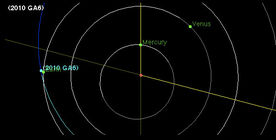
© NASA/JPL
This
NASA graphic depicts the orbit of newfound asteroid 2010 GA6 as it
flies by Earth on April 8, 2010 at a distance of 223,000 miles (359,000
km), about nine-tenths the distance between Earth and the moon.
This
NASA graphic depicts the orbit of newfound asteroid 2010 GA6 as it
flies by Earth on April 8, 2010 at a distance of 223,000 miles (359,000
km), about nine-tenths the distance between Earth and the moon.
A
newly discovered asteroid will zip close by Earth Thursday, but poses
no threat of crashing into our planet even though it is passing within
the orbit of the moon.
The asteroid, called 2010 GA6, is a relatively small space
rock about 71 feet (22 meters) wide and was discovered by astronomers
with the Catalina Sky Survey in Tucson, Az. The space rock will fly
within the orbit of the moon when it passes Earth Thursday at 7:06 p.m.
EDT (2306 GMT), but NASA astronomers said not to worry...the planet is
safe.
"Fly bys of near-Earth objects within the moon's orbit occur
every few weeks," said Don Yeomans of NASA's Near-Earth Object Office
at the Jet Propulsion Laboratory in Pasadena, Calif., in a statement.
At the time of its closest pass, asteroid 2010 GA6 will be
about 223,000 miles (359,000 km) from the Earth. That's about
nine-tenths the distance between Earth and the moon [more asteroid photos].
The space rock is not the first asteroid to swing close by Earth this year.
In January, the small asteroid 2010 AL30 passed within 80,000 miles
(130,000 km) when it zipped by. Other space rocks have flown past Earth
at more comfortable distances greater than several hundred thousand
miles.
NASA routinely tracks asteroids and comets that may fly near
the Earth with a network of telescopes on the ground and in space. The
agency's Near-Earth Object Observations program, more commonly known as
Spaceguard, is responsible for finding potentially dangerous asteroids
and studying their orbits to determine if they pose a risk of hitting
the Earth.
NASA's latest space telescope, the Wide-field Infrared Survey
Explorer (WISE) launched in December, has been given the task of
hunting new asteroids that were previously undetectable because they
shine only in the infrared range of the light spectrum.
So far, the WISE telescope has been discovering dozens of previously unknown asteroids
every day. Some of those space rocks have been tagged for closer
analysis since they may be potentially hazardous to Earth, WISE mission
scientists have said.
Latest Worldwide Meteor/Meteorite News
Tue, 06 Apr 2010 10:20 EDT
How to report a North American meteor observation?
Fireball Report Form.
Have you seen an extremely bright meteor? Share your sighting with
others across the globe by filling out our fireball report form.
View the meteor reports here!
RE: [Meteorite-List] Michigan Fireball 10:15pm reported
posted by Mike Bandli
I show two reports stating due north of Buffalo. If this is
correct, then the ASGARD camera network may have captured it (a la
Grimsby).
Re: [meteorite-list] Michigan Fireball 10:15pm, reported by LAWISFICTION
I was wondering if I am the only one who saw the blue ball
streaking through the sky just after 10:00pm here in Western
Connecticut.. it also had a red tail and looked like it was a northwest
trajectory ... this had a glimmering red tail ... is this the same
meteor as seen in Michigan ???
Anonymous ": I just saw a huge meteor falling in Michigan
about 10:15 tonight. It had a giant blue ball with a red tail. It fell
north of 30 mile road around I94 or west of 94. Anyone else see
anything?
Another fireball reported in Pennsylvania
Wednesday, April 7, 2010 11:32 AM, by MIke Antonelli on Meteorite-List
Just got a call from an eye witness, saw a large fireball
travelin from southeast to northwest @ 10:10 pm...No sonic boom reports
yet...
Pennsylvania fireball report, by MIke Antonelli on Meteorite-list@meteoritecentral.com
Just got a call from an eye witness, saw a large fireball
travelin from southeast to northwest @ 10:10 pm...No sonic boom reports
yet...
source: American Meteor Society
David Shiga
New Scientist
Wed, 07 Apr 2010 00:50 EDT
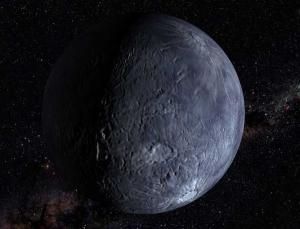
© NASA/G. Bacon/STScI
Quaoar, a large object in the outer solar system, is mostly made of rock, unlike its icy neighbours
Quaoar, a large object in the outer solar system, is mostly made of rock, unlike its icy neighbours
A
giant rock is walking among the "dirty iceballs" in the outer solar
system, a new study suggests. Researchers say it may have journeyed
there from the asteroid belt near Mars, or it may have been the victim
of a cosmic crash that blasted away its once-icy exterior.
Quaoar was discovered
in 2002 in the Kuiper belt, a ring of icy bodies beyond Neptune. At
about 900 kilometres across, or 40 per cent as wide as Pluto, it is not
the biggest denizen of the belt, but researchers now say it may be the
densest.
Wesley Fraser and Michael Brown
of Caltech confirmed its size by studying archival images from the
Hubble Space Telescope. They also used Hubble images to study the
motion of its moon, Weywot, which allowed them to calculate Quaoar's
mass.
Combining the size and mass revealed Quaoar's density to be
between 2.9 and 5.5 grams per cubic centimetre. That is much higher
than that of other Kuiper belt residents like Pluto, which has a
density of about 2.0 grams per cubic centimetre.
Quaoar's high density suggests it is made almost entirely of
rock, unlike its neighbours, which are a mixture of ice and rock, the
researchers conclude. They say the rocky world may be a refugee from
the asteroid belt between Mars and Jupiter, thrown outwards early in
the solar system's history, when the orbits of the giant planets are thought to have shifted.
'Far-fetched' scenario
Previously, other researchers have suggested that the same upheaval threw some Kuiper belt objects into the asteroid belt, so the new study suggests the migration may have been a two-way street.
But Renu Malhotra
of the University of Arizona in Tucson says that hurling Quaoar from
the asteroid belt to the Kuiper belt would have left it with an
elongated orbit, making it hard to explain why Quaoar is on a nearly
circular orbit today.
"I think that's pretty far-fetched," she says.
She favours the other possible explanation that Fraser and
Brown suggest - that a collision with another Kuiper belt object
blasted off most of Quaoar's ice, leaving behind only its dense, rocky
core.
"That kind of thing seems a lot more possible to me," she
says, noting that there were probably far more objects in the early
Kuiper belt than there are today, making collisions more common in the
past.
Journal reference: Astrophysical Journal Letters (in press)
Could a Comet Tail Have Scarred the Earth in the Recent Past?
Technology Review
Wed, 07 Apr 2010 06:00 EDT
One of the puzzles that geologists occasionally ponder is the nature of eskers and drumlins.
Eskers are winding ridges a few tens of metres high that look
remarkably like railway embankments. Indeed they are often used as
readymade roads and run up and down hills over distances that sometimes
stretch to hundreds kilometres.
Drumlins, on the other hand, are tear drop-shaped hills a few
tens of metres high and a hundreds of metres long. They often appear in
large numbers with the same orientation in drumlin fields .
Geologists have long assumed that eskers and drumlins are formed by glaciers and left behind after these ice giants retreated.
There are essentially two problems. The first is the internal
structure of these formations. Eskers and drumlins have have an outer
layer of water-borne clay and silt with attendant fossil debris. This
covers an inner core made of unsorted boulders and rocks which are
entirely free of fossils. These inner cores do not appear to have been
affected by the action of water. How does this structure arise?
The second is that if glaciers are responsible for eskers and
drumlins, they ought to be forming now. And yet nobody can find
anywhere on Earth where these structures are currently forming.
Today, Milton Zysman and Frank Wallace publish on the arXiv
their explanation for the formation of these objects and it makes for
fascinating, if not entirely convincing, reading.
Zysman and Wallace say that eskers and drumlins are
the debris left on Earth after our planet repeatedly passed through the
tail of a giant comet. They say this explains the distribution of
eskers and drumlins, which often form in roughly parallel lines.
It also explains their internal structure. The rocky core of these
objects is pure cometry debris which explains the absence of fossils.
The outer layer built up later through the action of water and ice.
The cometary origin, they say, also explains the rather unique
shape of the individual rocks in the cores and the striations that mark
them predominantly in line with their longest axis. (Apparently, these
markings are consistent with the process of erosion that must occur in
comet tails.)
Zysman and Wallace also point out that the ice age that is
associated with esker and drumlin formation must have been caused by
the comet tail, which would have enveloped Earth in a layer of dust
that rapidly cooled the planet.
This is not an entirely new idea. Various commentators have
suggested that many of Earth's rocks and much of its water and
atmosphere may have come from comets. And indeed this paper is an
edited version of one the authors originally gave in 1997.
However, Zysman and Wallace's idea as it stands is little more
than an interesting guess. What of isotopic evidence? Presumably the
isotopic content of the rocky cores should differ in a measurable way
from material on Earth that has other origins. If this work has been
done, they make no mention of it.
And the fact that we have not seen eskers and drumlins forming
in the two hundred years that we've been looking does not mean they did
not form in the past, during the many millennia that glaciers were
ravaging the Earth. (In fact, there are recent reports that scientists
have seen a drumlin forming for the first time in Antarctica.)
And finally, it's hard to imagine that the debris from a comet
tail hitting the atmosphere at several tens of kilometres per second
would then land in a tear drop shape just a few tens of metres in size
or form a line a few tens of metres wide but hundreds of kilometres
long.
It should be straightforward to refute or dismiss this idea by
simulating of the kind of debris patterns that this kind of event would
produce. And in any case, the heat generated when rocks enter the
Earth's atmosphere melts their outer surface, giving them a "fusion
crust" that is easy to identify. Why don't the rocks in esker and
drumlin cores have fusion crusts?
Putting Zysman and Wallace aside, however, it is still
possible that the Earth has been shaped by extraterrestrial forces in
ways that we are only beginning to grasp. For example, there is growing
evidence that the Solar System has been regularly disturbed by passing
stars and their accompanying discs of ice and dust. These events must
have had a dramatic impact on our world.
It is becoming increasingly clear that conditions on Earth are a product of the interplanetary and interstellar environment in ways we are only beginning to understand. And of course we need new hypotheses to explore this idea to its fullest extent.
Ref: arxiv.org/abs/1004.0416: "Tails of a Recent Comet: The Role Cometary Jets Play in Crustal Formation Esker" / Drumlin Swarms
Comment: For more information, read Laura Knight-Jadczyk's"Meteorites, Asteroids, and Comets: Damages, Disasters, Injuries, Deaths, and Very Close Calls".
The icy visitor from the outer solar system appeared with no warning
on April 9th and plunged into the sun during the early hours of April
10th. One comet went in, none came out. The Solar and Heliospheric
Observatory (SOHO) had a good view of the encounter.
The comet was probably a member of the Kreutz sungrazer
family. Named after a 19th century German astronomer who studied them
in detail, Kreutz sungrazers are fragments from the breakup of a giant
comet at least 2000 years ago. Several of these fragments pass by the
sun and disintegrate every day. Most are too small to see but
occasionally a big fragment like today's attracts attention.
This has been an active year for big, bright
sungrazers. There was one on Jan. 4th, one on March 12th, and now one
today. Normally we see no more than 3 or 4 bright ones in a whole year;
now we're seeing them almost once a month. It could be a statistical
fluctuation or, maybe, a swarm of Kreutz fragments is nearing
perihelion (closest approach to the sun). Stay tuned for doomed comets!
Click here to watch the movie.
On
April 5th, space shuttle Discovery blasted off from Cape Canaveral at
the crack of dawn. The shuttle began its journey in darkness--the sun
was still below the horizon--but moments after it left the pad,
Discovery burst into high altitude sunlight and proceeded to put on an
extraordinary show. University of Florida astronomy professor Howard
Cohen describes what he saw from his home in Gainesville, more than 130
miles from the Cape.
"The launch began in typical fashion- a brilliant, yellowish
glow rising out of the southwest gradually morphing into a white
contrail. Impatient observes might have thought that was it. But then
an amazing contrail, the likes of which I have never seen before,
rapidly appeared around and following the shuttle's path. For a short
time it resembled a comet streaking across the dawn sky." He took this
picture using his Canon EOS 5D.
"In binoculars the view was stunning and chilling,"
Cohen continues. "It was like viewing a comet traveling in fast motion
-- I could see the contrail unfolding, glistening and wavering behind
the shuttle. Unlike some who might have thought something might have
gone wrong, this never entered my mind. I could easily see the shuttle
unhesitatingly moving forward."
Atmospheric optics Les Cowley believes the cloud formed when
the shuttle entered the mesosphere. Water vapor spewing from the
shuttle's main engines began to freeze, forming crystals of just the
right size to scatter sunlight and produce the iridescent colors shown
in so many photos.
"I think we had a 'perfect storm' for this launch," concludes
Cohen. "Atmospheric conditions including probably cold and moist air,
clear skies and especially sunlight at just the right angle produced
this unique effect. Unfortunately, with the shuttle program coming to
an end, we probably will not see this again."
Comment: For more information, see SOTT's Best of the Web Article: Cosmic Climate Change: Space Shuttle Discovery - STS 131 leaves spectacular dragon trails in the sky
Phew! It was only a meteorite. "I thought someone shot at me," Jack
Steenhof said of his close encounter with an otherworldly kind.
The Oro-Medonte Township resident was on his way to a meeting in Kitchener when something shattered his sunroof.
"It was like a sniper hit me," he said, describing the
bullet-sized hole that was surrounded by cracked glass. The safety
glass held together, preventing the glass, and the foreign object, from
striking Steenhof.
The timing was perfect -- or, at least, as good is it can get
in such a situation. Steenhof was westbound on Highway 7 at Highway
400, and was travelling less than 10 kilometres an hour at the time. On
his way to pick up a colleague from a carpool lot, he was approaching a
stoplight when the astral assault occurred.
After the impact, Steenhof heard a clattering on the
roof of his vehicle. He pulled over, surveyed the damage and found a
rock-like nugget, about an inch long, on his roof.
"It's amazing that I can still have it in my hand," he said.
After doing some research online, looking at other meteorites, Steenhof
figured that's exactly what hit his sunroof.
A local astrophysicist thinks so, too. "It really does look
like a meteorite," said Tom Stiff, a NASA consultant who teaches at
Lakehead University's Orillia campus.
The object, which appears to be an iron-nickel meteorite, has
distinct marks that indicate "re-entry erosion," he said, as opposed to
erosion that occurs on the earth.
"It looks like the surface, at one point, was heated to the
vaporization point," Stiff said. This particular chunk struck about
7:30 a.m., and Stiff said meteorites are more abundant in the morning.
Meteorites are not rare, he said, noting "thousands and
thousands" fall every day. But it is rare for them to make it to the
earth's surface without burning up.
"And it's extremely rare to be hit by a meteorite," he said.
Steenhof might buy a lottery ticket after this experience. "It seemed
so incredible -- the odds of that happening," he said.
Photos of the object have been forwarded to a meteorite expert
for further examination, but Stiff is pretty sure it's the real deal.
That big boom heard Sunday night near the Sellwood Bridge that's got
Facebook and Twitter all lit up could have been a pipe bomb.
Portland police said Monday afternoon that investigators from
the police bureau's Explosives Disposal Unit discovered what appeared
to be evidence of a large pipe bomb that had been detonated in Powers
Marine Park.
The explosion's big BOOM! at about 8:05 p.m. Sunday
set off car alarms and startled people across Sellwood and Southeast
Portland. Dozens of people called 9-1-1 reporting the sound. Within
hours, a Facebook page dedicated to the "mysterious boom (3-28-10)" was
created with a link to a Google map showing a large concentration of people in the Sellwood area who reported hearing the sound.
Portland firefighters responded to the area within minutes of the sound, but were unable to find anything that could have caused the explosion.
It was the second loud boom heard in the area in two weeks. Another explosion/boom was reported March 15 near the same location.
Monday morning, however, police found what they was "evidence of a
large pipe bomb." Investigators believe that the sound was amplified to
the east because of its placement near the bank and river and the low
cloud cover.
Police said no property was damaged by the pipe bomb.
The police bureau's explosives unit is continuing its investigation.
Comment: The
Google Map linked from above shows that the "Boom" could be heard in a
very large area of 30km diameter. For this, it surely must have been a
very large bomb, and it would have left traces somewhere. If the
firefighters were "unable to find anything that could have caused the
explosion", and "no property was damaged" maybe there was another
cause?
No cover up to see here folks, just move along please! Oh look, a terrorist!

© Patrick Boomer
Patrick
Boomer, captured these photographs Southwest of Red Deer, Alberta,
Canada. These comparison photos of Comet McNaught, taken on Jan. 6th,
Jan. 7th and Jan 9th (2007) shows the difference a day makes. Both
photos were taken at 5:36pm local time.
Patrick
Boomer, captured these photographs Southwest of Red Deer, Alberta,
Canada. These comparison photos of Comet McNaught, taken on Jan. 6th,
Jan. 7th and Jan 9th (2007) shows the difference a day makes. Both
photos were taken at 5:36pm local time.
Comet
McNaught, the so-called Great Comet of 2007, has been identified as the
biggest comet measured to date, according to scientists, whose
calculations were based on the comet's overall influence in space.
Instead of using the length of the comet's tail to measure the
scale of the comet, astronomers used data from the ESA/NASA Ulysses
spacecraft to determine the size of the region of space disturbed by
the comet's presence - a cosmic wake across the solar system.
Through analysis of magnetometer data, scientists found
evidence of a decayed shockwave surrounding the comet, which was
created when ionized gas emitted from the comet's nucleus joined the
fast-flowing particles of the solar wind. That, in turn, caused the
solar wind around the comet to abruptly slow down.
Great Comet McNaught
Comet C/2006 P1 McNaught was discovered by astronomer Robert H.
McNaught in August 2006. In January and February 2007, Comet McNaught
became the brightest comet visible from Earth for the past 40 years. [Photos of Comet McNaught.]
Serendipitously, the robotic Ulysses spacecraft made an unexpected
crossing of Comet McNaught's tail in 2007, which allowed astronomers to
collect valuable and pertinent data.
Ulysses encountered McNaught's tail of ionized gas downstream
of the comet's nucleus, at a distance of more than 1.5 times the
distance between the Earth and the sun. That's about 139 million miles
(224 million km). The average distance between the Earth and sun,
called 1 astronomical unit, is about 93 million miles (150 million km).
This was far longer than the spectacular dust tail that was visible from Earth in 2007.

© NASA
This
image from the SECCHI/HI-1B instrument on the NASA STEREO-B (Behind)
spacecraft was taken on January 11, 2007 just after the door covering
the instrument was opened for the first time after the STEREO launch on
October 26, 2006. The image is dominated by a spectacular view of Comet
C/2006 P1 (McNaught).
This
image from the SECCHI/HI-1B instrument on the NASA STEREO-B (Behind)
spacecraft was taken on January 11, 2007 just after the door covering
the instrument was opened for the first time after the STEREO launch on
October 26, 2006. The image is dominated by a spectacular view of Comet
C/2006 P1 (McNaught).
Ulysses' 2007 encounter with
McNaught was one of three unplanned encounters that Ulysses made with
comet tails during its 19-year mission, which ended in 2009. The other
encounters included Comet Hyakutake in 1996. Hyakutake is the current record-holder for the comet with the longest measured tail.
Measuring a comet
But the data collected from Ulysses' encounter with McNaught allowed scientists to gauge the size of that comet.
"It was very difficult to observe Comet McNaught's plasma tail remotely
in comparison with the bright dust tail, so we can't really estimate
how long it might be," said Dr. Geraint Jones of University College
London's Mullard Space Science Laboratory, who will present the
findings at the Royal Astronomical Society National Astronomy Meeting
in Glasgow, Scotland, on April 13.
"What we can say is that Ulysses took just 2.5 days to
traverse the shocked solar wind surrounding Comet Hyakutake, compared
to an incredible 18 days in shocked wind surrounding Comet McNaught,"
Jones said. "This shows that the comet was not only spectacular from
the ground, it was a truly immense obstacle to the solar wind."
Scientists also compared the crossing times for other comet
encounters, which further revealed the huge scale of Comet McNaught.
The Giotto spacecraft's encounter with Comet Grigg-Skjellerup in 1992,
for example, took less than an hour from one shock crossing to another.
Similarly, it took only a few hours to cross the shocked region of the
famed Halley's Comet.
In 2007, the nucleus of Comet McNaught was estimated to be
less than 15 miles (25 km), but Jones used a different measure to
calculate the comet's scale.
"The scale of an active comet depends on the level of
outgassing rather than the size of the nucleus," Jones explained.
"Comet nuclei aren't necessarily active over their entire surfaces;
what we can say is that McNaught's level of gas production was clearly
much higher than that of Hyakutake."
Did you see what looked like a fireball in the sky about 11:15 p.m. Wednesday?
Jolene Miller of Goshen said she was letting the dog out when she
looked up and saw what looked just like a large shooting star, white
with a red tail. The object then became all red as it appeared to burn
out.
Miller, who lives near the Elkhart County fairgrounds, said she watches the stars often in the evening.
"We have nothing but field around us," she said. "I can see a long ways."
Another report was heard on a police scanner just before Miller's call to WSBT.
If you, too, saw what looked like a fireball, let us know at
the SBT24/7 News desk at (574) 247-6397 or send an email to
news@sbt247.com -- and of course, post your comments on wsbt.com or the
Facebook page.
Cedar Rapids - If you were outside enjoying the weather Wednesday
night, you might have spotted a cosmic light show streak across the
Iowa sky.
The meteor burning through the atmosphere appeared to be a
"giant fireball" and reports have been coming into the KCRG-TV9
newsroom from viewers across Eastern Iowa, southwest Wisconsin and
northwest Illinois.
KCRG-TV9 First Alert Storm Team Meteorologist Justin Gehrts said that falling stars like this are quite common and that they're nothing to worry over.
.
Comment: Nothing to see here folks! Just a giant fireball heading your way! And don't mind if it explodes at ground level and starts fires!
Something it up the sky in the Madison area Wednesday night, the question is - what was it?
Dozens of people called the 27 Newsroom shortly after 10:00 PM to
report a bright light in the sky. Calls came in from all over south
central Wisconsin, and from as far away as St. Louis.
Sharon Wisniewski, spokesperson for the Dane County Regional
Airport, confirms pilots on two aircrafts witnessed what looked like a
bright meteor in the sky. They believe it burned out. One pilot was
flying a helicopter, the other a plane.
Ken in Madison said the sky "Lit up just like daylight" and then it was gone.
Tara in Oregon told us she saw a bright green light come from the west before disappearing in the southeast.
Rhonda in Fitchburg said something lit up the large windows in her home, and within moments, it was gone.
Cheryl in Dodgeville says she saw a bright flash of light and then her house rumbled.
Callers in Livingston and Clyde Township claim they not only saw the light, they felt an impact.
People in as far away as Westfield report seeing the light, and questioned whether it was a plane in trouble.
27 News Chief Meteorologist Bob Lindmeier says it is possible a
large meteor passed through the area, but it's hard to know exactly
what caused the bright light. "Most meteors never reach the ground." He
said. "They typically disintegrate in the atmosphere." Lindmeier says
the disintegration could cause a rumbling sound.
If you have pictures or video of the whatever it was that lit up the sky, please call or email the 27 Newsroom.
(608) 273-2727 or news@wkowtv.com
Milwaukee -- Dozens of viewers called 12 News to report a huge fireball in the sky Wednesday night.
The flash of light in the sky was reported just after 10 p.m.
Viewers reported seeing all sorts of colors and one big blast followed by several smaller blasts.
WISN Chief Meteorologist Mark Baden said people from as far away as Iowa and Ohio saw the fireball which was likely a meteor.
"A meteor is a rock, hurdling through space, as it hits our atmosphere
it becomes super heated because of friction and this would normally
cause the rock to explode and that would create the big flash, visible
for hundreds of miles," Baden said.
"A meteor of this size is pretty unusual," Baden added.
Local police departments fielded dozens of phone calls.
Dispatchers from Muskego, New Berlin and Waukesha told 12 News they
searched for a possible impact site but didn't find one.
If you happened to capture the meteor on camera, we would like to see it.
Please email your picture to wisntvnews@hearst.com.
A
large meteor sighting occurred over West Michigan late Wednesday
evening. Calls to the WZZM 13 Information Center started around 11:10
pm with the first report of a large 'fireball' near Rothbury in Oceana
Co. Numerous viewers from Grant, Muskegon and Grand Rapids called in
with similar information of a 'meteor' streaking across the sky from
northwest to southeast.
Video courtesy of University of Wisconsin: Click here.
Video courtesy of Howard Co. Wisconsin Sheriff Deputy Tim Beckman: Click here.
National Weather Service offices across the Midwest reported
the same siting from Des Moines and Davenport IA, outside of Kansas
City MO, and in Portage, Milwaukee, Rock and Winnebago (WI) counties.
The meteor could be part of the Gamma Virginids meteor shower
which started on April 4 and lasts through April 21, with the peak
expected around April 14 or 15.
Fireball Fan Page on Facebook: Click here.
Mary Rinzel
WEAU 13 News
Thu, 15 Apr 2010 10:32 EDT
National Weather Service says it appears a meteorite lit up the sky over southwest Wisconsin Wednesday night
The National Weather Service out of La Crosse says it's receiving
numerous calls about a bright light and loud boom in the area.
The NWS says it appears that a meteorite was the source. They
say it would be larger than your typical shooting star to make it this
far into the atmosphere.
The NWS says the calls are mostly from Crawford, Richland and Vernon Counties. The calls are also keeping dispatch centers busy.
People say they saw a "fire ball" or "bright light." Some say their homes or windows shook.
The NWS says they are not sure if the meteor had landed but they say it was visible from as far away as Missouri and Chicago.
Peter Davenport
NUFORC
Thu, 15 Apr 2010 16:51 EDT
Occurred: 2/28/2010 18:40 (Entered as : 02/28/2010 18:40)
Reported: 2/28/2010 7:54:17 PM 19:54
Posted: 4/13/2010
Location: Homestead/Redlands/Everglades, Florida
Shape: Other
Duration: 10 minutes
Two large fireballs fall from the sky and split into 10 traveling orbs.
My friend and I were driving home from work and noticed what we thought
was a large meteor falling from the sky. The meteor was falling for a
much longer duration and was significantly larger that I was accustomed
to seeing. It looked like a burning fireball traveling at a high speed.
It kept falling and then split into two smaller burning fireballs and
continued to fall. Well before it hit the ground each meteor split into
two orbs or lights (thus four total) and each light turned and traveled
horizontal to the ground. They were no longer falling. We then noticed
a fifth and all five were traveling at different speeds to the west. We
watched them fly for several minutes until they got so far we could no
longer see them. They did not fly in any formation and appeared to be
traveling at different speeds and altitudes.
Next we noticed a second fireball that did the exact
same thing. There were 10 orbs or lights total traveling in two groups
of five towards the west. We watched them for about 5 minutes. The
lights were white with no color.

© University of Wisconsin - AOS/SSEC
The
meteor was bright green at first, and the sky was almost blue for a few
seconds. The meteor then broke into several pieces and glowed orange as
it faded away. Was visible for 10-15 seconds. The loop shows a plane
going by, then the fireball that illuminates the contrail of that plane
(and another from a previous plane that is not visible) The pictures
were taken at 10PM CDT on April 14, 2010 (03 UTC April 15, 2010)
The
meteor was bright green at first, and the sky was almost blue for a few
seconds. The meteor then broke into several pieces and glowed orange as
it faded away. Was visible for 10-15 seconds. The loop shows a plane
going by, then the fireball that illuminates the contrail of that plane
(and another from a previous plane that is not visible) The pictures
were taken at 10PM CDT on April 14, 2010 (03 UTC April 15, 2010)
Last
night, around 10:05 pm CDT, sky watchers in Minnesota, Wisconsin, Iowa,
Illinois and Missouri witnessed a brilliant green fireball streaking
across the sky. Images from a rooftop webcam in Madison, Wisconsin,
show a brilliant midair explosion.
The fireball was caused by a small asteroid hitting Earth's
atmosphere at a shallow angle. Preliminary infrasound measurements
place the energy of the blast at 20 tons of TNT (0.02 kton), with
considerable uncertainty. Bill Cooke of NASA's Meteoroid Environment
Office estimates that the space rock was about 1 meter wide and massed
some 1260 kg. "Fireballs of this size are surprisingly common," he
notes. "They hit Earth about 14 times a month, on average, although
most go unnoticed because they appear during the day or over
unpopulated areas."
Many readers have asked if fragments of the meteoroid
might have reached Earth. The answer is yes. Cooke advises looking
directly underneath the fireball's debris trail, which was pinged by
National Weather Service radars in Iowa. Click here and here for maps.

© University of Wisconsin - AOS/SSEC
Channel 3000
Many area residents reported a possible meteor flying across the sky over southern Wisconsin on Wednesday night.
Authorities were flooded with curious callers after a meteor streaking
across the Midwestern sky looked like a huge fireball. National Weather
Service offices in La Crosse, Wis., Des Moines, Iowa, and Kansas City,
Mo., received numerous reports of the fireball from law enforcement
officials and the public.
The flash of light in the sky was reported just after 10 p.m.
People from Iowa to Ohio have apparently reported seeing a fireball.
Witnesses reported seeing all sorts of colors and one big blast followed by several smaller blasts.
Forecasters said that a meteor shower called Gamma Virginids began
April 4 and is expected to last to April 21 with peak activity
Wednesday and Thursday, but they couldn't immediately confirm if
Wednesday night's incident was part of that shower.
While there's been no official confirmation of what the
alleged object was or the nature of the incident, some witnesses in
southern Wisconsin were sharing what they saw and felt on Wednesday
night.
Jeff Boyle said he was on his way home from work in Waukesha
when he saw a ball in the sky with a huge tail that was as bright as
the sun.
Janesville resident Valon Pajaziti said he was returning from
a friend's house to his home when he saw what he described as "the most
amazing thing I have ever seen" just after 10 p.m.
"As I was parking my car and I got out of the car, I saw this
big lightning falling down. I had my phone in my hand and I wanted to
record it, but I was too focused and amazed by what was happening that
I never got to recording it. I thought I took a few pictures, but I
guess I only took one," said Pajaziti, who is originally from Kosovo.
Another resident, Luis Gaytan Tovar, also captured a photo of
the incident through his car windshield as it passed overhead from
north to south. His friend, Scott Mickelson, said the photo was taken
just as the alleged object was breaking into multiple pieces.
Desiree Dailey, of Richland Center, said she spotted the
object while standing on the corner of East Haseltine and South Sheldon
Streets.
"It was really low. It was just a huge flame. It was really
bright. I didn't know what it was. I thought it was a meteor," said
Dailey.
Erik and Jenyl Nerenz said they were heading southbound on
Interstate 39 when the sky suddenly lite up to the west at around 10:15
p.m.
"We saw an extremely bright light streak across the sky
directly in front of us over the interstate. We watched the light burn
out and split into what looked to be a few pieces and looked to be a
100 yards in front of us," said Jenyl Nerenz. "Whatever it was, was
definantly on fire. It appeared to be heading toward the power plant in
Portage. We traveled out to the area that we thought it had fallen in.
We saw nothing, but noticed heavy animal traffic in that area."
Other south-central Wisconsin residents reported feeling a shaking sensation.
"I don't know for sure, but it sure felt like an earthquake
here in Lancaster (in Grant County)," said Carol Burton. "It couldn't
be thunder as the stars are shining. No emergency trucks or anything
going on. It shook the whole house and rattled the windows."
Dodgeville's Denny Marklein also described what he thought could be a meteor
"I observed what appeared to be the moon coming through an
overcast sky. The light, which appeared far away, continued to get
brighter as it approached from the west to the east. Out of the light
appeared two large round very bright, fiery fireballs moving west to
east. They had fairly long dazzling tails and appeared to be
comet-like. They passed over my head and burned out," said Marklein.
Mark Jung called the sight "spectacular."
"I saw a very large fast moving object breaking up in the
western sky near Lake Waubesa at 10:07 p.m. It looked like a meteor,
but bigger than any I have ever seen before," said Jung.
Using
data from the completed ESA/NASA Ulysses mission, scientists have
identified a new candidate for biggest comet. Results of these findings
were presented at the Royal Astronomical Society's National Astronomy
Meeting in Glasgow by Ulysses science team member Geriant Jones of
University College, London.
The primary mission of the Ulysses spacecraft was to
characterize the sun's heliosphere as a function of solar latitude. The
heliosphere is the vast region of interplanetary space occupied by the
sun's atmosphere and dominated by the outflow of the solar wind.
To study the heliosphere, Ulysses was placed into a six-year
orbit around the sun that carried it out to Jupiter's orbit and back.
Covering such a vast expanse of space provided unique and unexpected
opportunities for the spacecraft. During its more than 17-year mission,
Ulysses had three unplanned encounters with comet tails.
Scientists combed the data of a chance 2007 encounter
Ulysses made with the tail of comet McNaught. The nucleus of this comet
was some 257 million kilometers (160 million miles) from the spacecraft
during encounter. Instead of using the length of the tail to measure
the scale of the comet, scientists used Ulysses data to gauge the size
of the region of space disturbed by the comet's presence.
Ulysses' solar wind ion composition spectrometer instrument,
developed by University of Michigan heliophysicist George Gloeckler,
found that even at such a great distance, the tail had filled the solar
outflow with unusual gases and molecules.
In response, the solar wind that usually measures about 700
kilometers per second (435 miles per second) at that distance from the
sun, was less than 400 kilometers per second (249 miles per second)
inside the comet's tail, as measured by one of Ulysses' instruments
called "Solar Wind Observations Over the Poles of the Sun," whose
principal investigator is Dave McComas of the Southwest Research
Institute in San Antonio, Texas.
Ulysses took nearly nine times as long to traverse the tail of
comet McNaught in 2007 as it did during a 1996 chance encounter with
comet Hyakutake - which until now held the record for longest known
tail. This led scientists to believe the comet McNaught was remarkably
productive in releasing gas and material from its surface.
While measuring such comet "outgassing" can define the level
of activity of a comet, it does not directly relate to its size. But if
both comets were equally active, McNaught would have to be much larger
in size to produce such a massive tail.
The interaction between comets' tails and the solar wind has
been studied for decades. A comet's ion tail always points away from
the sun, whether the body is traveling toward or away from the sun
along the comet's elliptical orbit. It was this finding that eventually
led in 1958 to the discovery of solar wind. The magnetism and velocity
of the solar wind are so strong, the effect pushes the comet's tail
outward.
When space shuttle Discovery launched Ulysses on Oct. 6, 1990,
it had an expected lifetime of five years. The mission gathered unique
information about the heliosphere, the bubble in space carved by the
solar wind, for nearly four times longer than expected. The mission
ended on June 30, 2009.
The Ulysses spacecraft was built by Dornier Systems of Germany
for ESA. NASA provided the launch and the upper stage boosters. The
U.S. Department of Energy, Washington, supplied the generator that
powers the spacecraft; science instruments were provided by both U.S.
and European investigators. The spacecraft was operated from JPL by a
joint NASA/ESA team and employed NASA's Deep Space Network for
communications.
Andy Mannion
Posted: April 17, 2010
Location of Sighting: Epping, Essex CM16
Date of Sighting: Friday 16 April 2010
Time: 2302
Witness Statement: We were driving South
through the town and as we were passing Tower Road we both saw a bright
green light dropping very fast out of the sky from about 500 feet.
It was about half a mile ahead of us and to the West of the High Road.
It was visible for about 1 second before it disappeared from view
behind trees and we estimate that it dropped in the area of Bury Road,
Epping.
Associated Press
Cape
Canaveral, Florida - Landing a man on the moon was a towering
achievement. Now the president has given NASA an even harder job, one
with a certain Hollywood quality: sending astronauts to an asteroid, a giant speeding rock, just 15 years from now.
Space experts say such a voyage could take several months longer than a journey to the moon and entail far greater dangers.
"It is really the hardest thing we can do," NASA Administrator Charles Bolden said.
Going to an asteroid could provide vital training for an eventual
mission to Mars. It might help unlock the secrets of how our solar
system formed. And it could give mankind the know-how to do something
that has been accomplished only in the movies by a few square-jawed,
squinty-eyed heroes: saving the Earth from a collision with a killer
asteroid.
"You could be saving humankind. That's worthy, isn't it?" said
Bill Nye, TV's Science Guy and vice president of the Planetary Society.
President Barack Obama outlined NASA's new path during a visit to the Kennedy Space Center on Thursday.
"By 2025, we expect new spacecraft designed for long journeys
to allow us to begin the first-ever crewed missions beyond the moon
into deep space," he said. "We'll start by sending astronauts to an
asteroid for the first time in history."
On the day the president announced the goal, a NASA
task force of scientists, engineers and ex-astronauts was meeting in
Boston to work on a plan to protect Earth from a cataclysmic collision
with an asteroid or a comet.
NASA has tracked nearly 7,000 near-Earth objects that are
bigger than several feet across. Of those, 1,111 are "potentially
hazardous asteroids." Objects bigger than two-thirds of a mile are
major killers and hit Earth every several hundred thousand years.
Scientists believe it was a 6-mile-wide asteroid that wiped out the
dinosaurs 65 million years ago.
Landing on an asteroid and giving it a well-timed nudge "would
demonstrate once and for all that we're smarter than the dinosaurs and
can avoid what they didn't," said White House science adviser John
Holdren.
Experts don't have a particular asteroid in mind for the
deep-space voyage, but there are a few dozen top candidates, most of
which pass within about 5 million miles of Earth. That is 20 times more
distant than the moon, which is about 239,000 miles from Earth on
average.
Most of the top asteroid candidates are less than a quarter-mile across. The moon is about 2,160 miles in diameter.
Going to an asteroid could provide clues about the solar
system's formation, because asteroids are essentially fossils from 4.6
billion years ago, when planets first formed, said Don Yeomans, manager
of NASA's Near Earth Object program at the Jet Propulsion Lab.
And an asteroid mission would be a Mars training ground, given the distance and alien locale.
"If humans can't make it to near-Earth objects, they can't make it to Mars," said MIT astronautics professor Ed Crawley.
Also, asteroids contain such substances as hydrogen, carbon,
iron and platinum, which could be used by astronauts to make fuel and
equipment - skills that would also be necessary on a visit to Mars.
While Apollo 11 took eight days to go to the moon and back in
1969, a typical round-trip mission to a near-Earth asteroid would last
about 200 days, Crawley said. That would demand new propulsion and
life-support technology. And it would be riskier. Aborting a mission in
an emergency would still leave people stuck in space for several weeks.
The space agency may need to develop special living quarters,
radiation shields or other new technology to allow astronauts to live
in deep space so long, said NASA chief technology officer Bobby Braun.
Even though an asteroid would be farther than the moon, the
voyage would use less fuel and be cheaper because an asteroid has no
gravity. The rocket that carries the astronauts home would not have to
expend fuel to escape the asteroid's pull.
On the other hand, because of the lack of gravity, a spaceship
could not safely land on an asteroid; it would bounce off the surface.
Instead, it would have to hover next to the asteroid, and the
astronauts would have to spacewalk down to the ground, Yeomans said.
Once there, they would need some combination of jet packs,
spikes or nets to enable them to walk without skittering off the
asteroid and floating away, he said.
"You would need some way to hold yourself down," Yeomans said. "You'd launch yourself into space every time you took a step."
Just being there could be extremely disorienting, said
planetary scientist Tom Jones, co-chairman of the NASA task force on
protecting Earth from dangerous objects. The rock would be so small
that the sun would spin across the sky and the horizon would only be a
few yards long. At 5 million miles away, the Earth would look like a
mere BB in the sky.
"It's going to be a strange alien environment being on an asteroid," Jones said.
But Jones, a former astronaut, said that wouldn't stop
astronauts from angling to be a part of such a mission: "You'll have
plenty of people excited about exploring an ancient and alien world."
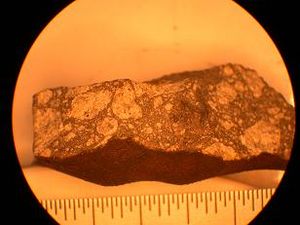
Soaring meteor lights up skies across the Midwest.
Scientists say an apparent fragment from a meteor that lit up
Midwestern skies this week has been recovered in southwestern
Wisconsin.
The fragment weighs 0.3 pounds and is about the size of an
unshelled peanut. The meteor had streaked across the sky about 10 p.m.
Wednesday and was visible from southern Wisconsin and northern Iowa to
central Missouri.
University of Wisconsin geology professor John Valley says
fragment has a so-called fusion crust. The paper-thin blackened coating
results when a meteor superheats as it speeds through the atmosphere.
Valley says the man who found the fragment lent it to university scientists for a two-hour analysis.
Based on preliminary tests, the meteor appears to have come from the vast asteroid belt between Mars and Jupiter.
Source: Associated Press
Comment: HUGE fireball turns sky bright green over southern Wisconsin, starts 9 fires along 1-mile stretch
Evan Harding
What's that streaking across Southland skies? Is it a meteor, is it a plane?
Probably a meteor, according to Southland Astronomical Society secretary Bob Evans.
Probably a plane, Southland Astronomical Society observatory director Steve Butler said yesterday.
Otahu Flats dairy farmers Chris and Valda Johnstone sent this photo to The Southland Times last night, saying they watched a long vapour trail slowly descend towards Earth on about a 45-degree angle just before 5pm.
"We were trying to work out what it was. The first impression I had was
it was a meteorite or some piece of space junk, or an aeroplane going
away from us," Mr Johnstone said.
"But it was slow. I have never seen anything like it before."
His wife Valda said she had also never seen anything like it before, and she was a stargazer.
"I love to sit out at night and watch the sky."
Mr Butler, when emailed the photo last night, said the Johnstones'
comment that it was slowly falling towards the north suggested it was a
high-flying aircraft rather than a meteor, which travelled quite
quickly across the sky.
There were two trails, suggesting jet contrails, with Mr
Butler saying it could be a flight from Antarctica to Christchurch or a
commercial flight from Chile to Sydney because they sometimes overflew
Invercargill.
However, Mr Evans said he believed it was a meteor, or a rock "fireball" that had travelled through space.
"It's obviously broken into two pieces and as it's going
through the atmosphere it's leaving an incandescent trail." Carter
Observatory staff in Wellington could not be contacted for their
thoughts last night.
In January last year, The Southland Times reported people seeing striking patterns in the skies over Southland.
On that occasion, experts agreed it was a commercial airliner's
vapour trails about 10,000m high, understood to have originated from
Qantas Boeing 747-400 planes flying regular non-stop return routes
between South America and Sydney.
But this mystery is yet to be solved. Watch this space ...
A meteor shower is believed to have sparked a spate of calls to
coastguards on Friday night from people who thought they were seeing
flares or UFOs.
A Portland coastguard spokesman said there had been reports of
green flare sightings up and down the coast, from Brixham to
Southampton, at around 10pm.
"We were right in the middle of meteorite activity so no action was taken."
A Christchurch man told the Daily Echo: "We saw the lights around 11.30pm. They definitely weren't Chinese lanterns, when we were out in the garden.
"It was really strange."
US: Fayetteville residents rattled by mysterious, loud boom
Elizabeth Doran
The boom was so loud it shook houses in Fayetteville and was followed by a bright flash.
A scene right out of a Stephen King novel or the latest sci-fi movie
came to Fayetteville Saturday night, but no one is quite sure what
happened.
A sonic boom from a plane? A fireworks explosive set off by kids? A blown transformer or street light?
Or could it be some unsuspecting creature that got "fried" by electricity from a power line and then vaporized on the spot?
Susan Rausch, who lives on Oakwood Drive in Fayetteville,
jumped out of her seat when she heard the boom that caused the house to
shake.
"I can't imagine what it could have been," she said. "It
sounded like a gas explosion. It was so loud I jumped out and ran
outside to see if I could see or smell anything. But there was
nothing."
The loud boom and bright flash of light was seen, heard and
felt by Fayetteville residents in a roughly a 2- to 3-mile circlular
area centered around Hoag Lane by Wellwood Middle School and Redfield
Drive near Immaculate Conception School, Manlius police said.
Numerous calls came into the 911 center, and Manlius
Police were joined by Manlius and Fayetteville fire departments in
sending out crews. It was dispatched as a house explosion.
The mystery lingers. Several Fayetteville residents
interviewed Monday at their homes say they've been scratching their
heads ever since.
"We have no idea what it was," said Capt. Bill Bleyle, of the
Manlius Police Department. " We investigated and when the sun came up
on Sunday, still nothing. We still don't know."
Police and fire investigations couldn't find any blown
transformers in the area, no explosions, and no resulting power outage.
One theory, Bleyle said, is that sometimes an animal comes across a
power line and is hit and there's a quick flash and bang and then the
animal is nearly vaporized.
Courtney Quatrino, speaking for National Grid, said animals
can come into contact with equipment and get burned. That could cause a
"popping noise" and "quick flash of light," and not necessarily disrupt
power, she said. Usually, there's some trace of the animal left, but
it's not always found, she said.
Tom Canning was sitting in his television room on Edgemere
Drive in Fayetteville when he heard "BOOM" and thought 'what the heck?"
Last fall, a street light blew near him and the sound was similar,
Canning said, but this time the light stayed on. His wife thought it
sounded like a gunshot.
"It was just this big BOOM, and my wife and I just looked at
each other," he said. "It was much louder than any fireworks
explosive."
Karen Shephardson, who lives on Cammot Lane and works for the
village of Fayetteville, said she thought it was a transformer. "We had
the bathroom fan on and it was still audible, so I knew it was loud
enough to be unusual," she said. "I guess it's just one of those fluke
things, and we'll never know."
The lifeguard captured the meteorite in a mobile phone video:
An
unidentified object thought to be a small meteor fell from the sky on
one of Bat Yam's beaches, just south of Tel Aviv, Saturday afternoon,
Ynet has learned.
No injuries were reported, but witnesses said the object fell
very close to the lifeguard booth and caused a small fire. The
meteorite landed in a beach earmarked for religious visitors that
features separate swimming times for men and women.
The beach was crowded at the time of the incident, and many visitors gathered around the object after it landed.
Police said the object was a meteor and sappers headed to the scene in order to look into the celestial object.
'It kept on burning'
The lifeguard who saw the meteorite land, Yisrael Rokach, told Ynet:
"In the morning, as always, I embarked on a patrol in the water...when
I returned towards the beach I spotted a small object landing from
above and starting to burn."
"At first I didn't understand what happened; I thought someone
threw it down from above," the lifeguard said. "When I got closer I saw
a small object that kept on burning and smoking. I immediately called
my fellow lifeguards, who didn't believe me. They came down and at the
same time we called the police.
Another lifeguard, Yossi Mizrahi, said: "The meteorite kept on
burning and gave off an odd smell. It kept on burning even when we put
it in the water and it melted seashells as if they were candles."
Mizrahi added that the object did not make any noise when it landed and that there were no sounds of an explosion at the site.
"Fortunately nobody was hurt by it, as the beach was crowded," he said.
Chairman of the Israeli Astronomical Association, Igal Patel, said the object was a meteorite.
"Meteorites fall all the time, but one falling in a residential
area before the eyes of witnesses is indeed a rare occurrence," he
said.
Patel added that most meteorites are burned up by the atmosphere, but
"once in many years you can see a fireball falling in a populated
area".
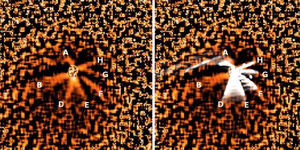
Scientists from the Max Planck Institute for Solar System Research identify the active regions on the surface of comets.
Studying comets can be quite dangerous - especially from close up.
Because the tiny particles of dust emitted into space from the
so-called active regions on a comet's surface can damage space probes.
Scientists from the Max Planck Institute for Solar System Research in
Germany have now developed a computer model that can locate these
regions using only the information available from Earth. The new method
could help calculate a safe flight route for ESA's space probe Rosetta,
which is scheduled to arrive at the comet Churyumov-Gerasimenko in
2014. (Astronomy & Astrophysics, 512, A60, 2010)
A comet's nucleus is much more than an unvarying chunk of ice and dust.
Under the Sun's influence, volatile substances such as water, carbon
dioxide, and carbon monoxide are emitted from certain regions on its
surface - the so-called active regions - carrying dust particles with a
diameter of up to a few centimetres into space. Seen from Earth, these
fountains of dust can be discerned as jets or spiral arms that surround
the comet (see figure 1). These structures are embedded in a sheath of
gas and dust called the coma that is produced by the more uniform
activity of the overall surface.
"Pictures taken from Earth show the comet and its jets as a
two-dimensional projection", explains Hermann Böhnhardt from the Max
Planck Institute for Solar System Research (MPS). Where exactly the
dust particles and gases originate from can not therefore be well
identified.
In order to localize the active regions despite this problem,
the MPS-researchers chose an indirect approach that for the first time
also accounts for the three dimensional shape of the comet. "Until now,
computer programs trying to find the active regions assumed the comet
as a sphere or ellipsoid", explains Jean-Baptiste Vincent from MPS.
Since in reality comets often have quite bizarre shapes, for many
applications this approach is not good enough. The researchers
therefore decided to take a standard approach: While watching a comet
for an entire rotation period, changes in its luminance allow its true
form to be calculated.
In a next step, the researchers fed their program with an
initial assumption where the active regions might be located.
Additionally they made an "educated guess" concerning the physical
properties of the dust particles like size and initial velocity upon
emission from the nucleus. As a result, the computer simulation
delivers an image as it would be seen through a telescope on Earth. By
comparing this with the actual image through a telescope the model can
be refined step by step until simulation and actual image agree.
Already, the new method has passed its first test: The
scientists could successfully apply it to the comet Tempel 1 that was
the destination of NASA's Deep Impact Mission in 2005. "Even though
ever since this mission we know where Tempel1's active regions are, we
pretended not to", explains Vincent. For their computer program the
scientists only used information that was available from Earth-base
observations - apart from the nucleus shape model that was adopted from
the mission results.
Next, the researchers intend to calculate the active regions
of the comet Churyumov-Gerasimenko, the rendezvous target for ESA's
Rosetta mission on which the Rosetta lander Philae will touch down in
late 2014. The mission, to which MPS contributed many scientific
instruments, has been on route to its destination beyond the orbit of
Mars and the asteroid belt since 2004. In the crucial phase of the
mission, the new method could help to determine a safe route for
Rosetta through the cometary coma and maybe even find a suitable
landing site.
Original work:
J.-B. Vincent, H. Böhnhardt, and L.M. Lara
A numerical model of cometary dust coma structures - Application to comet 9P/Tempel 1
Astronomy&Astrophysics 512, A60 (2010) DOI: 10.1051/0004-6361/200913418
Channel 3000
Thu, 15 Apr 2010 18:21 EDT
Many area residents reported a possible meteor flying across the sky over southern Wisconsin on Wednesday night.
Authorities were flooded with curious callers after a meteor streaking
across the Midwestern sky looked like a huge fireball. National Weather
Service offices in La Crosse, Wis., Des Moines, Iowa, and Kansas City,
Mo., received numerous reports of the fireball from law enforcement
officials and the public.
The flash of light in the sky was reported just after 10 p.m.
People from Iowa to Ohio have apparently reported seeing a fireball.
Witnesses reported seeing all sorts of colors and one big blast followed by several smaller blasts.
Forecasters said that a meteor shower called Gamma Virginids began
April 4 and is expected to last to April 21 with peak activity
Wednesday and Thursday, but they couldn't immediately confirm if
Wednesday night's incident was part of that shower.
While there's been no official confirmation of what the
alleged object was or the nature of the incident, some witnesses in
southern Wisconsin were sharing what they saw and felt on Wednesday
night.
Jeff Boyle said he was on his way home from work in Waukesha
when he saw a ball in the sky with a huge tail that was as bright as
the sun.
Janesville resident Valon Pajaziti said he was returning from
a friend's house to his home when he saw what he described as "the most
amazing thing I have ever seen" just after 10 p.m.
"As I was parking my car and I got out of the car, I saw this
big lightning falling down. I had my phone in my hand and I wanted to
record it, but I was too focused and amazed by what was happening that
I never got to recording it. I thought I took a few pictures, but I
guess I only took one," said Pajaziti, who is originally from Kosovo.
Another resident, Luis Gaytan Tovar, also captured a photo of
the incident through his car windshield as it passed overhead from
north to south. His friend, Scott Mickelson, said the photo was taken
just as the alleged object was breaking into multiple pieces.
Desiree Dailey, of Richland Center, said she spotted the
object while standing on the corner of East Haseltine and South Sheldon
Streets.
"It was really low. It was just a huge flame. It was really
bright. I didn't know what it was. I thought it was a meteor," said
Dailey.
Erik and Jenyl Nerenz said they were heading southbound on
Interstate 39 when the sky suddenly lite up to the west at around 10:15
p.m.
"We saw an extremely bright light streak across the sky
directly in front of us over the interstate. We watched the light burn
out and split into what looked to be a few pieces and looked to be a
100 yards in front of us," said Jenyl Nerenz. "Whatever it was, was
definantly on fire. It appeared to be heading toward the power plant in
Portage. We traveled out to the area that we thought it had fallen in.
We saw nothing, but noticed heavy animal traffic in that area."
Other south-central Wisconsin residents reported feeling a shaking sensation.
"I don't know for sure, but it sure felt like an earthquake
here in Lancaster (in Grant County)," said Carol Burton. "It couldn't
be thunder as the stars are shining. No emergency trucks or anything
going on. It shook the whole house and rattled the windows."
Dodgeville's Denny Marklein also described what he thought could be a meteor
"I observed what appeared to be the moon coming through an
overcast sky. The light, which appeared far away, continued to get
brighter as it approached from the west to the east. Out of the light
appeared two large round very bright, fiery fireballs moving west to
east. They had fairly long dazzling tails and appeared to be
comet-like. They passed over my head and burned out," said Marklein.
Mark Jung called the sight "spectacular."
"I saw a very large fast moving object breaking up in the
western sky near Lake Waubesa at 10:07 p.m. It looked like a meteor,
but bigger than any I have ever seen before," said Jung.
Using
data from the completed ESA/NASA Ulysses mission, scientists have
identified a new candidate for biggest comet. Results of these findings
were presented at the Royal Astronomical Society's National Astronomy
Meeting in Glasgow by Ulysses science team member Geriant Jones of
University College, London.
The primary mission of the Ulysses spacecraft was to
characterize the sun's heliosphere as a function of solar latitude. The
heliosphere is the vast region of interplanetary space occupied by the
sun's atmosphere and dominated by the outflow of the solar wind.
To study the heliosphere, Ulysses was placed into a six-year
orbit around the sun that carried it out to Jupiter's orbit and back.
Covering such a vast expanse of space provided unique and unexpected
opportunities for the spacecraft. During its more than 17-year mission,
Ulysses had three unplanned encounters with comet tails.
Scientists combed the data of a chance 2007 encounter
Ulysses made with the tail of comet McNaught. The nucleus of this comet
was some 257 million kilometers (160 million miles) from the spacecraft
during encounter. Instead of using the length of the tail to measure
the scale of the comet, scientists used Ulysses data to gauge the size
of the region of space disturbed by the comet's presence.
Ulysses' solar wind ion composition spectrometer instrument,
developed by University of Michigan heliophysicist George Gloeckler,
found that even at such a great distance, the tail had filled the solar
outflow with unusual gases and molecules.
In response, the solar wind that usually measures about 700
kilometers per second (435 miles per second) at that distance from the
sun, was less than 400 kilometers per second (249 miles per second)
inside the comet's tail, as measured by one of Ulysses' instruments
called "Solar Wind Observations Over the Poles of the Sun," whose
principal investigator is Dave McComas of the Southwest Research
Institute in San Antonio, Texas.
Ulysses took nearly nine times as long to traverse the tail of
comet McNaught in 2007 as it did during a 1996 chance encounter with
comet Hyakutake - which until now held the record for longest known
tail. This led scientists to believe the comet McNaught was remarkably
productive in releasing gas and material from its surface.
While measuring such comet "outgassing" can define the level
of activity of a comet, it does not directly relate to its size. But if
both comets were equally active, McNaught would have to be much larger
in size to produce such a massive tail.
The interaction between comets' tails and the solar wind has
been studied for decades. A comet's ion tail always points away from
the sun, whether the body is traveling toward or away from the sun
along the comet's elliptical orbit. It was this finding that eventually
led in 1958 to the discovery of solar wind. The magnetism and velocity
of the solar wind are so strong, the effect pushes the comet's tail
outward.
When space shuttle Discovery launched Ulysses on Oct. 6, 1990,
it had an expected lifetime of five years. The mission gathered unique
information about the heliosphere, the bubble in space carved by the
solar wind, for nearly four times longer than expected. The mission
ended on June 30, 2009.
The Ulysses spacecraft was built by Dornier Systems of Germany
for ESA. NASA provided the launch and the upper stage boosters. The
U.S. Department of Energy, Washington, supplied the generator that
powers the spacecraft; science instruments were provided by both U.S.
and European investigators. The spacecraft was operated from JPL by a
joint NASA/ESA team and employed NASA's Deep Space Network for
communications.
Andy Mannion
UK UFO Sightings
Sat, 17 Apr 2010 19:15 EDT
Posted: April 17, 2010
Location of Sighting: Epping, Essex CM16
Date of Sighting: Friday 16 April 2010
Time: 2302
Witness Statement: We were driving South
through the town and as we were passing Tower Road we both saw a bright
green light dropping very fast out of the sky from about 500 feet.
It was about half a mile ahead of us and to the West of the High Road.
It was visible for about 1 second before it disappeared from view
behind trees and we estimate that it dropped in the area of Bury Road,
Epping.
Associated Press
Sat, 17 Apr 2010 11:45 EDT
Cape
Canaveral, Florida - Landing a man on the moon was a towering
achievement. Now the president has given NASA an even harder job, one
with a certain Hollywood quality: sending astronauts to an asteroid, a giant speeding rock, just 15 years from now.
Space experts say such a voyage could take several months longer than a journey to the moon and entail far greater dangers.
"It is really the hardest thing we can do," NASA Administrator Charles Bolden said.
Going to an asteroid could provide vital training for an eventual
mission to Mars. It might help unlock the secrets of how our solar
system formed. And it could give mankind the know-how to do something
that has been accomplished only in the movies by a few square-jawed,
squinty-eyed heroes: saving the Earth from a collision with a killer
asteroid.
"You could be saving humankind. That's worthy, isn't it?" said
Bill Nye, TV's Science Guy and vice president of the Planetary Society.
President Barack Obama outlined NASA's new path during a visit to the Kennedy Space Center on Thursday.
"By 2025, we expect new spacecraft designed for long journeys
to allow us to begin the first-ever crewed missions beyond the moon
into deep space," he said. "We'll start by sending astronauts to an
asteroid for the first time in history."
On the day the president announced the goal, a NASA
task force of scientists, engineers and ex-astronauts was meeting in
Boston to work on a plan to protect Earth from a cataclysmic collision
with an asteroid or a comet.
NASA has tracked nearly 7,000 near-Earth objects that are
bigger than several feet across. Of those, 1,111 are "potentially
hazardous asteroids." Objects bigger than two-thirds of a mile are
major killers and hit Earth every several hundred thousand years.
Scientists believe it was a 6-mile-wide asteroid that wiped out the
dinosaurs 65 million years ago.
Landing on an asteroid and giving it a well-timed nudge "would
demonstrate once and for all that we're smarter than the dinosaurs and
can avoid what they didn't," said White House science adviser John
Holdren.
Experts don't have a particular asteroid in mind for the
deep-space voyage, but there are a few dozen top candidates, most of
which pass within about 5 million miles of Earth. That is 20 times more
distant than the moon, which is about 239,000 miles from Earth on
average.
Most of the top asteroid candidates are less than a quarter-mile across. The moon is about 2,160 miles in diameter.
Going to an asteroid could provide clues about the solar
system's formation, because asteroids are essentially fossils from 4.6
billion years ago, when planets first formed, said Don Yeomans, manager
of NASA's Near Earth Object program at the Jet Propulsion Lab.
And an asteroid mission would be a Mars training ground, given the distance and alien locale.
"If humans can't make it to near-Earth objects, they can't make it to Mars," said MIT astronautics professor Ed Crawley.
Also, asteroids contain such substances as hydrogen, carbon,
iron and platinum, which could be used by astronauts to make fuel and
equipment - skills that would also be necessary on a visit to Mars.
While Apollo 11 took eight days to go to the moon and back in
1969, a typical round-trip mission to a near-Earth asteroid would last
about 200 days, Crawley said. That would demand new propulsion and
life-support technology. And it would be riskier. Aborting a mission in
an emergency would still leave people stuck in space for several weeks.
The space agency may need to develop special living quarters,
radiation shields or other new technology to allow astronauts to live
in deep space so long, said NASA chief technology officer Bobby Braun.
Even though an asteroid would be farther than the moon, the
voyage would use less fuel and be cheaper because an asteroid has no
gravity. The rocket that carries the astronauts home would not have to
expend fuel to escape the asteroid's pull.
On the other hand, because of the lack of gravity, a spaceship
could not safely land on an asteroid; it would bounce off the surface.
Instead, it would have to hover next to the asteroid, and the
astronauts would have to spacewalk down to the ground, Yeomans said.
Once there, they would need some combination of jet packs,
spikes or nets to enable them to walk without skittering off the
asteroid and floating away, he said.
"You would need some way to hold yourself down," Yeomans said. "You'd launch yourself into space every time you took a step."
Just being there could be extremely disorienting, said
planetary scientist Tom Jones, co-chairman of the NASA task force on
protecting Earth from dangerous objects. The rock would be so small
that the sun would spin across the sky and the horizon would only be a
few yards long. At 5 million miles away, the Earth would look like a
mere BB in the sky.
"It's going to be a strange alien environment being on an asteroid," Jones said.
But Jones, a former astronaut, said that wouldn't stop
astronauts from angling to be a part of such a mission: "You'll have
plenty of people excited about exploring an ancient and alien world."

© John Valley
Fragment of a meteorite from a meteor that blasted a debris field over a mile in length
Fragment of a meteorite from a meteor that blasted a debris field over a mile in length
Soaring meteor lights up skies across the Midwest.
Scientists say an apparent fragment from a meteor that lit up
Midwestern skies this week has been recovered in southwestern
Wisconsin.
The fragment weighs 0.3 pounds and is about the size of an
unshelled peanut. The meteor had streaked across the sky about 10 p.m.
Wednesday and was visible from southern Wisconsin and northern Iowa to
central Missouri.
University of Wisconsin geology professor John Valley says
fragment has a so-called fusion crust. The paper-thin blackened coating
results when a meteor superheats as it speeds through the atmosphere.
Valley says the man who found the fragment lent it to university scientists for a two-hour analysis.
Based on preliminary tests, the meteor appears to have come from the vast asteroid belt between Mars and Jupiter.
Source: Associated Press
Comment: HUGE fireball turns sky bright green over southern Wisconsin, starts 9 fires along 1-mile stretch
Evan Harding
The Southland Times
Wed, 21 Apr 2010 05:00 EDT
What's that streaking across Southland skies? Is it a meteor, is it a plane?
Probably a meteor, according to Southland Astronomical Society secretary Bob Evans.
Probably a plane, Southland Astronomical Society observatory director Steve Butler said yesterday.
Otahu Flats dairy farmers Chris and Valda Johnstone sent this photo to The Southland Times last night, saying they watched a long vapour trail slowly descend towards Earth on about a 45-degree angle just before 5pm.
"We were trying to work out what it was. The first impression I had was
it was a meteorite or some piece of space junk, or an aeroplane going
away from us," Mr Johnstone said.
"But it was slow. I have never seen anything like it before."
His wife Valda said she had also never seen anything like it before, and she was a stargazer.
"I love to sit out at night and watch the sky."
Mr Butler, when emailed the photo last night, said the Johnstones'
comment that it was slowly falling towards the north suggested it was a
high-flying aircraft rather than a meteor, which travelled quite
quickly across the sky.
There were two trails, suggesting jet contrails, with Mr
Butler saying it could be a flight from Antarctica to Christchurch or a
commercial flight from Chile to Sydney because they sometimes overflew
Invercargill.
However, Mr Evans said he believed it was a meteor, or a rock "fireball" that had travelled through space.
"It's obviously broken into two pieces and as it's going
through the atmosphere it's leaving an incandescent trail." Carter
Observatory staff in Wellington could not be contacted for their
thoughts last night.
In January last year, The Southland Times reported people seeing striking patterns in the skies over Southland.
On that occasion, experts agreed it was a commercial airliner's
vapour trails about 10,000m high, understood to have originated from
Qantas Boeing 747-400 planes flying regular non-stop return routes
between South America and Sydney.
But this mystery is yet to be solved. Watch this space ...
A meteor shower is believed to have sparked a spate of calls to
coastguards on Friday night from people who thought they were seeing
flares or UFOs.
A Portland coastguard spokesman said there had been reports of
green flare sightings up and down the coast, from Brixham to
Southampton, at around 10pm.
"We were right in the middle of meteorite activity so no action was taken."
A Christchurch man told the Daily Echo: "We saw the lights around 11.30pm. They definitely weren't Chinese lanterns, when we were out in the garden.
"It was really strange."
US: Fayetteville residents rattled by mysterious, loud boom
Elizabeth Doran
Syracuse.com
Mon, 19 Apr 2010 16:53 EDT
The boom was so loud it shook houses in Fayetteville and was followed by a bright flash.
A scene right out of a Stephen King novel or the latest sci-fi movie
came to Fayetteville Saturday night, but no one is quite sure what
happened.
A sonic boom from a plane? A fireworks explosive set off by kids? A blown transformer or street light?
Or could it be some unsuspecting creature that got "fried" by electricity from a power line and then vaporized on the spot?
Susan Rausch, who lives on Oakwood Drive in Fayetteville,
jumped out of her seat when she heard the boom that caused the house to
shake.
"I can't imagine what it could have been," she said. "It
sounded like a gas explosion. It was so loud I jumped out and ran
outside to see if I could see or smell anything. But there was
nothing."
The loud boom and bright flash of light was seen, heard and
felt by Fayetteville residents in a roughly a 2- to 3-mile circlular
area centered around Hoag Lane by Wellwood Middle School and Redfield
Drive near Immaculate Conception School, Manlius police said.
Numerous calls came into the 911 center, and Manlius
Police were joined by Manlius and Fayetteville fire departments in
sending out crews. It was dispatched as a house explosion.
The mystery lingers. Several Fayetteville residents
interviewed Monday at their homes say they've been scratching their
heads ever since.
"We have no idea what it was," said Capt. Bill Bleyle, of the
Manlius Police Department. " We investigated and when the sun came up
on Sunday, still nothing. We still don't know."
Police and fire investigations couldn't find any blown
transformers in the area, no explosions, and no resulting power outage.
One theory, Bleyle said, is that sometimes an animal comes across a
power line and is hit and there's a quick flash and bang and then the
animal is nearly vaporized.
Courtney Quatrino, speaking for National Grid, said animals
can come into contact with equipment and get burned. That could cause a
"popping noise" and "quick flash of light," and not necessarily disrupt
power, she said. Usually, there's some trace of the animal left, but
it's not always found, she said.
Tom Canning was sitting in his television room on Edgemere
Drive in Fayetteville when he heard "BOOM" and thought 'what the heck?"
Last fall, a street light blew near him and the sound was similar,
Canning said, but this time the light stayed on. His wife thought it
sounded like a gunshot.
"It was just this big BOOM, and my wife and I just looked at
each other," he said. "It was much louder than any fireworks
explosive."
Karen Shephardson, who lives on Cammot Lane and works for the
village of Fayetteville, said she thought it was a transformer. "We had
the bathroom fan on and it was still audible, so I knew it was loud
enough to be unusual," she said. "I guess it's just one of those fluke
things, and we'll never know."
The lifeguard captured the meteorite in a mobile phone video:
An
unidentified object thought to be a small meteor fell from the sky on
one of Bat Yam's beaches, just south of Tel Aviv, Saturday afternoon,
Ynet has learned.
No injuries were reported, but witnesses said the object fell
very close to the lifeguard booth and caused a small fire. The
meteorite landed in a beach earmarked for religious visitors that
features separate swimming times for men and women.
The beach was crowded at the time of the incident, and many visitors gathered around the object after it landed.
Police said the object was a meteor and sappers headed to the scene in order to look into the celestial object.
'It kept on burning'
The lifeguard who saw the meteorite land, Yisrael Rokach, told Ynet:
"In the morning, as always, I embarked on a patrol in the water...when
I returned towards the beach I spotted a small object landing from
above and starting to burn."
"At first I didn't understand what happened; I thought someone
threw it down from above," the lifeguard said. "When I got closer I saw
a small object that kept on burning and smoking. I immediately called
my fellow lifeguards, who didn't believe me. They came down and at the
same time we called the police.
Another lifeguard, Yossi Mizrahi, said: "The meteorite kept on
burning and gave off an odd smell. It kept on burning even when we put
it in the water and it melted seashells as if they were candles."
Mizrahi added that the object did not make any noise when it landed and that there were no sounds of an explosion at the site.
"Fortunately nobody was hurt by it, as the beach was crowded," he said.
Chairman of the Israeli Astronomical Association, Igal Patel, said the object was a meteorite.
"Meteorites fall all the time, but one falling in a residential
area before the eyes of witnesses is indeed a rare occurrence," he
said.
Patel added that most meteorites are burned up by the atmosphere, but
"once in many years you can see a fireball falling in a populated
area".

© Instituto de Astrofisica de Andalucia (Luisa Maria Lara)/MPS
A
look at the comet Tempel 1 through a telescope. The active regions are
responsible for the bright jets (left). With the help of their computer
simulation the MPS-scientists can reconstruct the image seen from Earth
(right).
A
look at the comet Tempel 1 through a telescope. The active regions are
responsible for the bright jets (left). With the help of their computer
simulation the MPS-scientists can reconstruct the image seen from Earth
(right).
Scientists from the Max Planck Institute for Solar System Research identify the active regions on the surface of comets.
Studying comets can be quite dangerous - especially from close up.
Because the tiny particles of dust emitted into space from the
so-called active regions on a comet's surface can damage space probes.
Scientists from the Max Planck Institute for Solar System Research in
Germany have now developed a computer model that can locate these
regions using only the information available from Earth. The new method
could help calculate a safe flight route for ESA's space probe Rosetta,
which is scheduled to arrive at the comet Churyumov-Gerasimenko in
2014. (Astronomy & Astrophysics, 512, A60, 2010)
A comet's nucleus is much more than an unvarying chunk of ice and dust.
Under the Sun's influence, volatile substances such as water, carbon
dioxide, and carbon monoxide are emitted from certain regions on its
surface - the so-called active regions - carrying dust particles with a
diameter of up to a few centimetres into space. Seen from Earth, these
fountains of dust can be discerned as jets or spiral arms that surround
the comet (see figure 1). These structures are embedded in a sheath of
gas and dust called the coma that is produced by the more uniform
activity of the overall surface.
"Pictures taken from Earth show the comet and its jets as a
two-dimensional projection", explains Hermann Böhnhardt from the Max
Planck Institute for Solar System Research (MPS). Where exactly the
dust particles and gases originate from can not therefore be well
identified.
In order to localize the active regions despite this problem,
the MPS-researchers chose an indirect approach that for the first time
also accounts for the three dimensional shape of the comet. "Until now,
computer programs trying to find the active regions assumed the comet
as a sphere or ellipsoid", explains Jean-Baptiste Vincent from MPS.
Since in reality comets often have quite bizarre shapes, for many
applications this approach is not good enough. The researchers
therefore decided to take a standard approach: While watching a comet
for an entire rotation period, changes in its luminance allow its true
form to be calculated.
In a next step, the researchers fed their program with an
initial assumption where the active regions might be located.
Additionally they made an "educated guess" concerning the physical
properties of the dust particles like size and initial velocity upon
emission from the nucleus. As a result, the computer simulation
delivers an image as it would be seen through a telescope on Earth. By
comparing this with the actual image through a telescope the model can
be refined step by step until simulation and actual image agree.
Already, the new method has passed its first test: The
scientists could successfully apply it to the comet Tempel 1 that was
the destination of NASA's Deep Impact Mission in 2005. "Even though
ever since this mission we know where Tempel1's active regions are, we
pretended not to", explains Vincent. For their computer program the
scientists only used information that was available from Earth-base
observations - apart from the nucleus shape model that was adopted from
the mission results.
Next, the researchers intend to calculate the active regions
of the comet Churyumov-Gerasimenko, the rendezvous target for ESA's
Rosetta mission on which the Rosetta lander Philae will touch down in
late 2014. The mission, to which MPS contributed many scientific
instruments, has been on route to its destination beyond the orbit of
Mars and the asteroid belt since 2004. In the crucial phase of the
mission, the new method could help to determine a safe route for
Rosetta through the cometary coma and maybe even find a suitable
landing site.
Original work:
J.-B. Vincent, H. Böhnhardt, and L.M. Lara
A numerical model of cometary dust coma structures - Application to comet 9P/Tempel 1
Astronomy&Astrophysics 512, A60 (2010) DOI: 10.1051/0004-6361/200913418
Near-Earth
asteroid 2005 YU55 was "imaged" by the Arecibo Radar Telescope in
Puerto Rico on April 19. Data collected during Arecibo's observation of
2005 YU55 allowed the Near-Earth Object Program Office at NASA's Jet
Propulsion Laboratory to refine the space rock's orbit, allowing
scientists to rule out any possibility of an Earth impact for the next
100 years.
The space rock was about 2.3 million kilometers (1.5 million
miles) from Earth at the time this image of the radar echo was
generated. The ghostly image has a resolution of 7.5 meters (25 feet)
per pixel. It reveals 2005 YU55 as a spherical object about 400 meters
(1,300 feet) in size.
Not only can the radar provide data on an asteroid's
dimensions, but also on its exact location in space. Using Arecibo's
high-precision radar astrometry capability, scientists were able to
reduce orbit uncertainties for YU55 by 50 percent.
"At one time we had classified 2005 YU55 as a potential
threat," said Steve Chesley, a scientist at JPL's Near-Earth Object
Program Office. Prior to the Arecibo radar passes on April 19 thru 21,
we had eliminated almost all upcoming Earth flybys as possibilities of
impact. But there were a few that had a low remaining probability of
impact. After incorporating the data from Arecibo, we were able to rule
impacts out entirely for the next 100 years."
With more observations in the coming years, scientists may be able to accurately plot 2005 YU55's orbit even further out.
NASA detects, tracks and characterizes asteroids and comets
passing close to Earth using both ground- and space-based telescopes.
The Near-Earth Object Observations Program, commonly called
"Spaceguard," discovers these objects, characterizes a subset of them,
and plots their orbits to determine if any could be potentially
hazardous to our planet.
JPL manages the Near-Earth Object Program Office for NASA's
Science Mission Directorate in Washington. JPL is a division of the
California Institute of Technology in Pasadena.
More information about asteroids and near-Earth objects is at: http://www.jpl.nasa.gov/asteroidwatch.
Scientists Say Ice Lurks In Asteroid's Cold Heart
Jet Propulsion Laboratory
Thu, 29 Apr 2010 21:12 EDT

© NASA/JPL-Caltech
In this artist's concept, a narrow asteroid belt filled with rocks and dusty debris orbits a star similar to our own sun.
In this artist's concept, a narrow asteroid belt filled with rocks and dusty debris orbits a star similar to our own sun.
Scientists
using a NASA funded telescope have detected water-ice and carbon-based
organic compounds on the surface of an asteroid. The cold hard facts of
the discovery of the frosty mixture on one of the asteroid belt's
largest occupants, suggests that some asteroids, along with their
celestial brethren, comets, were the water carriers for a primordial
Earth. The research is published in today's issue of the journal
Nature.
Scientists using a NASA funded telescope have detected
water-ice and carbon-based organic compounds on the surface of an
asteroid. The cold hard facts of the discovery of the frosty mixture on
one of the asteroid belt's largest occupants, suggests that some
asteroids, along with their celestial brethren, comets, were the water
carriers for a primordial Earth. The research is published in today's
issue of the journal Nature.
"For a long time the thinking was that you couldn't find a
cup's worth of water in the entire asteroid belt," said Don Yeomans,
manager of NASA's Near-Earth Object Program Office at the Jet
Propulsion Laboratory in Pasadena, Calif. "Today we know you not only
could quench your thirst, but you just might be able to fill up every
pool on Earth - and then some."
The discovery is a result of six years of observing asteroid
24 Themis by astronomer Andrew Rivkin of the Johns Hopkins University
Applied Physics Laboratory in Laurel, Maryland. Rivkin, along with
Joshua Emery, of the University of Tennessee in Knoxville, employed the
NASA Infrared Telescope Facility to take measurements of the asteroid
on seven separate occasions beginning in 2002. Buried in their compiled
data was the consistent infrared signature of water ice and
carbon-based organic materials.
The study's findings are particularly surprising because it
was believed that Themis, orbiting the sun at "only" 479 million
kilometers (297 million miles), was too close to the solar system's
fiery heat source to carry water ice left over from the solar system's
origin 4.6 billion years ago.
Now, the astronomical community knows better. The research
could help re-write the book on the solar system's formation and the
nature of asteroids.
"This is exciting because it provides us a better
understanding about our past - and our possible future," said Yeomans.
"This research indicates that not only could asteroids be possible
sources of raw materials, but they could be the fueling stations and
watering holes for future interplanetary exploration."
Rivkin and Emory's findings were independently confirmed by a
team led by Humberto Campins at the University of Central Florida in
Orlando.
NASA detects, tracks and characterizes asteroids and comets
passing close to Earth using both ground- and space-based telescopes.
The Near-Earth Object Observations Program, commonly called
"Spaceguard," discovers these objects, characterizes a subset of them,
and plots their orbits to determine if any could be potentially
hazardous to our planet.
JPL manages the Near-Earth Object Program Office for NASA's
Science Mission Directorate in Washington. JPL is a division of the
California Institute of Technology in Pasadena.
Indonesia: Blast in East Jakarta Believed to Be Meteorite
Ronna Nirmala & Zaky Pawas
Jakarta Globe
Fri, 30 Apr 2010 05:51 EDT

© JG Photo/Yudhi Sukma Wijaya
This
house at Jl. Delima, East Jakarta, was among three rocked by a
mysterious explosion on Thursday. Police have ruled out reports that it
was caused by an exploding gas canister.
This
house at Jl. Delima, East Jakarta, was among three rocked by a
mysterious explosion on Thursday. Police have ruled out reports that it
was caused by an exploding gas canister.
Police and
astronomers are investigating Thursday's blast from a falling object
that damaged three homes in Duren Sawit, East Jakarta, which witnesses
claim was a meteorite strike.
Forensics experts from the police and National Aeronautics and
Space Agency (Lapan) investigators are combing the site, with the
latter saying that while there was no conclusive proof the damage was
caused by a meteorite, it was the most likely explanation.
Police ruled out earlier speculation that the incident was a gas canister exploding.
One house was moderate damage and two adjoining properties
suffered minor damage after blast on Jalan Delima II. There were no
reported casualties.
Lapan researcher Abdurrahman said no fragments of the
projectile had been found but the deep crater in the floor of the
house, the residual heat footprint and melted items pointed to a
meteorite.
"I suspect the object impacted at high velocity, hit the floor, bounced
back and hit the ceiling, then fell back down," he said. "It's
extremely difficult to recover the fragments, what with the rubble and
broken glass, and it being so dark in here."
Abdurrahman said any suspected meteorite fragment would be taken back to Lapan's headquarters in Bandung for analysis.
Researcher Evan Irawan Akbar, from the Bosscha Observatory in Lembang,
Bandung, said if the projectile was a meteorite it warranted further
investigation.
"This kind of incident is extremely rare in Indonesia," he
said. "Usually an object that falls to earth is burned up in the
atmosphere before reaching land."
The incident comes on the heels of the Lyrid meteor shower,
which ended on Monday, but Evan ruled out any connection between the
two.
"It could, however, be part of the Eta Aquariid meteor shower, which peaks on May 7 and 8," he said.
The phenomenon often begins in late April.
"Another possibility is that this wasn't a meteorite at all, but man-made space debris like a satellite," Evan said.
Police, meanwhile, are pursuing their own line of
investigation. Jakarta Police spokesman Sr. Comr. Boy Rafli Amar said
the Densus 88 counterterrorism squad had been called in to search for
possible traces of explosives.
The homes of Sunarti, Sudarmojo and Marzuki were damaged in
the incident, with Sudarmojo's house taking the brunt of the impact. It
blasted a hole in the second floor of the house, sending furniture
falling to the first floor, and tore big holes in the walls.
Last October, a mysterious explosion in Bone, South Sulawesi,
was determined to have been a meteorite that hit the Earth's atmosphere
at a mind-boggling 20.3 kilometers per second.
According to Thomas Djamaluddin, head of atmospheric sciences and chief
of astronomy research at Lapan, the blast released energy equal to
about 50 kilotons of TNT, more than three times the force of the atomic
bomb dropped on Hiroshima, Japan, near the end of World War II.
A 9-year-old girl suffered a fatal cardiac arrest after
hearing the explosion, and shock waves damaged homes in Bone's Panyula
village.
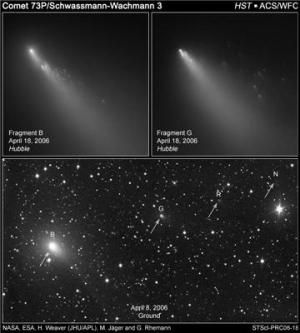
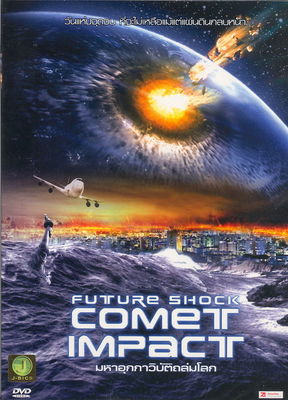
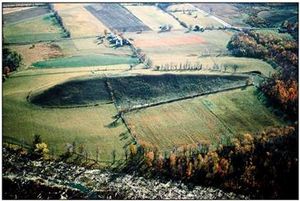
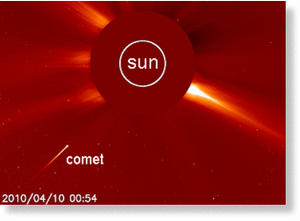


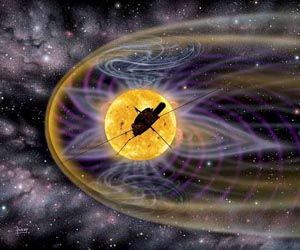

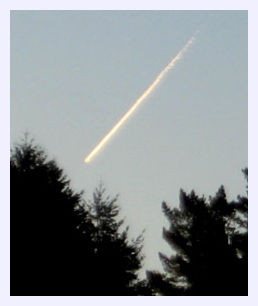

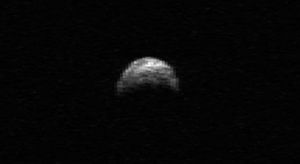
No comments:
Post a Comment